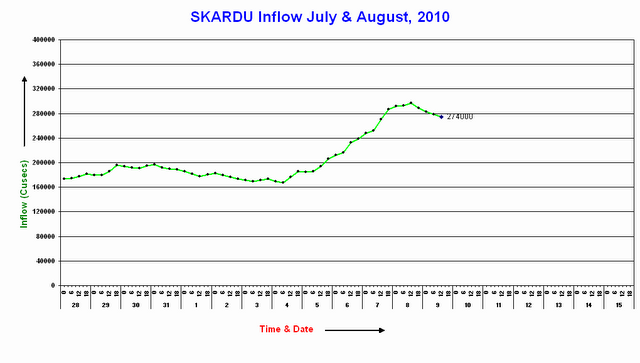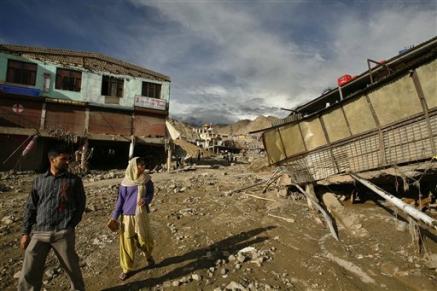9 August 2010
Updates on landslides and floods in Pakistan, China and India
Posted by Dave Petley
It is rather difficult to keep up with all the landslides occurring in Asia at present, so for now I’ll provide a brief review of the current situation across the three major areas affected:
1. Pakistan
The situation in Pakistan becomes increasingly desperate. Further heavy rainfall in the mountains in the northwest has meant increased landslide and flood occurrence, and a huge reduction in the aid effort. The FFD hydrographs in the mountain areas are steadily rising again. For example, this hydrograph is for Skardu shows that flow is greater now than it was in the heavy rainfall of ten days ago:
Downstream at Besham (close to the mountain front) the discharge is not as high as it was in the first set of floods, but it is rising and the level is undoubtedly high:
The area under the curve is the total volume of water that has been involved in the flood. This suggests that in terms of overall volume this flood is larger than that of the events last week, even though the peak flow is (so far) lower.
Downstream at Sukkur and Guddu the flow remains exceptionally high. At Guddu the hydrograph suggests that the peak flow has now been maintained for over 24 hours. This looks odd – I wonder whether the discharge has exceeded the capacity of the measurement system.
However, according to the FFD a larger discharge has been measured at Guddu before – in 1986 a discharge of 1,200,000 cusecs (cubic feet per second) was measured at this point.
At Sukkur the discharge is continuing to rise, and based upon the Guddu hydrograph may have some time to go before the peak is reached. The maximum recorded flood at this point is 1,170,000 cusecs in 1986.
GEO News is reporting that the city of Muzaffargarh is now being evacuated. Given that this is a city of 165,000 people, the severity of the situation is clear.
2. China
Xinhua continues to provide full coverage of the desperate attempts to save people trapped by the landslide in Zhouqu, Gansu Province yesterday. The magnitude of the slide is clear from the story of the survivor rescued this morning – she was recovered from a an apartment that had been inundated by debris. The rescuers had to break through a wall to reach her – even though her apartment was on the fourth floor of the building. Meanwhile the landslide dam has been successfully breached, which at least deals with one key issue.
3. India
The debris flow at Ladakh is now known to have killed 132 people, but a further 500 people are reported to be missing. The level of damage is really very high indeed, as this AP image shows:
A fascinating insight into the process that occurred at Leh is provided by this commentary from geologist Ritesh Arya, who was in the head scar area when the failures developed:
Describing the sheer size of the mudslide, Arya said: “Its dimensions make it so scary: it was about 20meter high and several kilometers wide.” All the houses coming in its way appeared to just dissolve into it as it roared on, destroying the Leh bus stand and the BSNL exchange, said Arya. The mudslide is believed to have travelled 6km, bulldozing the Choglamsar village. Arya said most roads have disappeared under the debris. The worst-hit are the heritage buildings and old houses, traditionally made of mud.
“‘People were completely caught unawares. Then suddenly, everyone started scrambling as the enormous amount of loose mud and debris was unleashed. Those who survived in the Choglamsar village had to waded through five-ft high mudflow,” said Arya. “There are bodies still buried in the debris and I found arms and legs sticking out at several places,” he said.”






 Dave Petley is the Vice-Chancellor of the University of Hull in the United Kingdom. His blog provides commentary and analysis of landslide events occurring worldwide, including the landslides themselves, latest research, and conferences and meetings.
Dave Petley is the Vice-Chancellor of the University of Hull in the United Kingdom. His blog provides commentary and analysis of landslide events occurring worldwide, including the landslides themselves, latest research, and conferences and meetings.
You have collated the information very well.Pakistan situation is very bad. There are flash floods and landslides in mountain areas. Lot of loss of property and infrastructure. I think a time has come for an International conference on Landslides,GLOF in mountain areas of Pakistan,India,Nepal etc.
The Pakistan disaster Authority is putting the death toll at 1313 people however aid organizations are of the view that that number could rise to 1500 people.